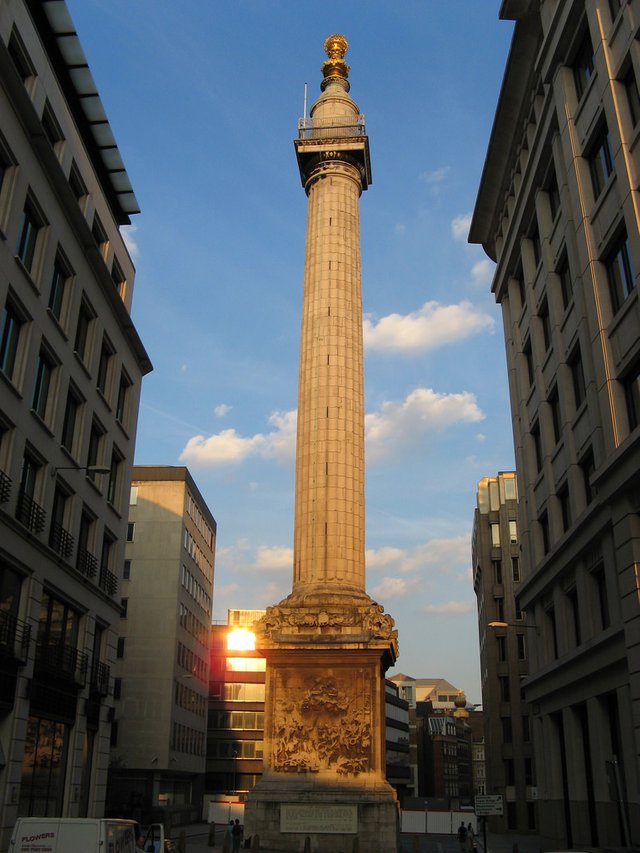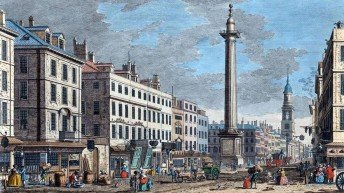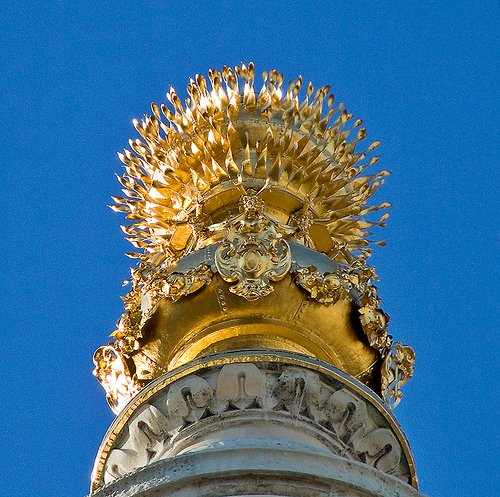
London is full of monuments. But there is only one Monument, with a capital M.
Easy to find, you'd think, since it's given its name to Monument tube station. But in fact it's tucked away into a little warren of streets off Eastcheap and below the approach to Tower Bridge - one of my favourite little nooks and crannies in the City.
The Great Fire of London was the transforming event of the modern City. Though the difficulties of transforming London into a modern, baroque townscape were too great - and the street pattern reverted to the higgledy piggledy medieval wriggles and bends, instead of a rational grid with fine open squares - Christopher Wren's new classical style churches and the fine brick terraces of merchants' houses created a baroque city with a flavour all its own, quite different from the still essentially late medieval City that Shakespeare would have known.
(If you want to see what Wren would like to have made the City look like, you only have to take a trip to Fitzrovia or Bloomsbury, or even Regent's Park, and look at the fine terraces, the open streets, circuses, and squares. Imagine that, with Wren's churches and the dome of St Paul's looming over the top, and you have pretty much what we would have got. if Wren had had his way.)
I digress - let's get back to the Monument.

This fine column was erected in 1677 to commemorate the Great Fire. It's a rather clever monument, since its height is exactly the same as the distance from its base to the place the fire started, in Pudding Lane. Now this is even cleverer than it looks, since there's a Classical precedent; Trajan's column was designed to be exactly as tall as the hill that Trajan had removed to open up the Roman forum. So this column recalls Trajan's column - even though its sides are fluted, not decorated with spiral strip-cartoons like Trajan's.
The Monument is all made in Portland stone - the 'new' building material of Wren's City. You'll recognise it from St Paul's cathedral and the other City churches. Its gleaming, creamy surface and the ease with which it could be carved made it a superb material for this gracious architecture - though unfortunately it also makes the impact of years of traffic fumes and acid rain highly visible.
Inside, a cantilevered stone staircase spirals up, leaving the centre open as a light well. It's surprisingly spacious and light - not at all what you'd expect looking from the outside. Even inside a seemingly solid column, Wren's values - rationality, elegance, spaciousness, light - triumph over the difficulties of engineering.
On top, a copper urn has flames belching from it. (For years, I thought it was a misshapen pineapple.) You don't get quite that far - at the top of the 311 stairs you come out to the wire-caged viewing gallery.

The views are surprisingly good. The Monument has disappeared into the skyline of the City so that from a distance, it's almost invisible, and you might think there were no views. But you can see all the way to Crystal Palace or the Isle of Dogs - and down into the maze of little streets in the City.
I'm amazed the Monument isn't on the top ten lists of what to do in London. It's cheaper than the London Eye, and you get Wren's fine architecture thrown in as well as the views. It's tucked away in a maze of little streets, with some fine churches nearby to visit (weekdays only) including the lovely St Magnus Martyr almost at the bottom of the Monument. And it's not full of coach parties - at least it never has been when I've visited.
I lived in London for 2 years and loved walking around that area. There's so many amazing little nooks and crannies around there just waiting to be discovered.
Great post!
Downvoting a post can decrease pending rewards and make it less visible. Common reasons:
Submit